
How AI-Powered Emotion Analysis Decodes Mark Zuckerberg's Leadership Traits?
What can a CEO emotion analysis of Mark Zuckerberg, the mastermind behind Meta and its connection to billions, tell us about human connection? We gain insight into the emotional intelligence that has shaped him as a leader by analyzing his facial expressions, body language, and words.
Our advanced emotion recognition technology (Emotion AI) uncovers emotions that often go unnoticed by the human eye. While people may miss emotions that flash across a face in mere milliseconds, our emotion detection software captures these subtle moments frame by frame, giving us a deeper understanding of the man behind the tech giant.
Video interviews have become a powerful tool for understanding public figures, especially in the context of sentiment analysis of CEOs. Social media platforms have become a crucial part of our lives, influencing public opinion and shaping cultural trends. To gain deeper insights into Mark Zuckerberg, we applied our state-of-the-art video emotion analysis to his recent Bloomberg interview. This Emotion AI analysis provides a unique view of his emotional intelligence, revealing the underlying traits and psychological factors that have contributed to his success.
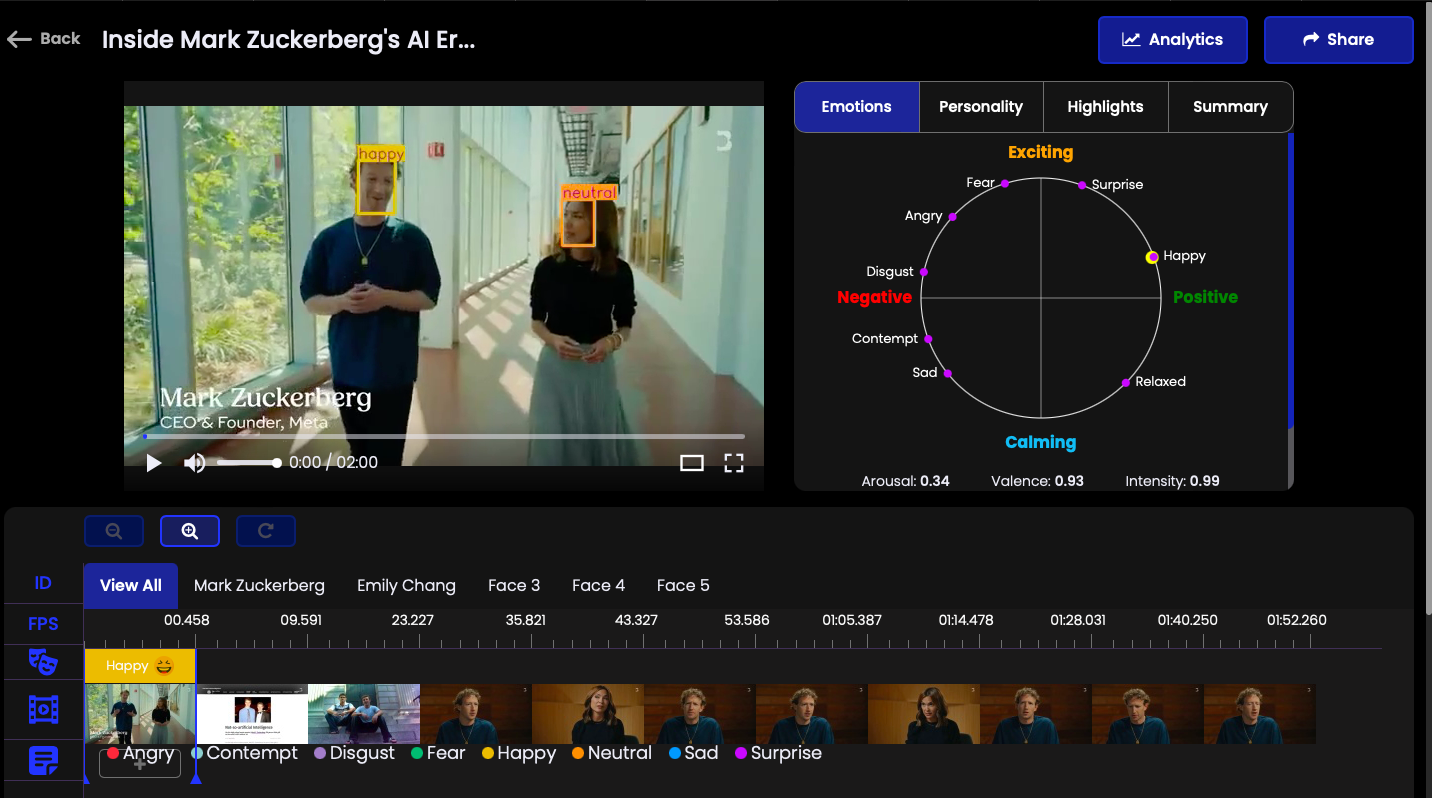
Zuckerberg presented a mix of seriousness and approachability, portraying himself as a leader deeply focused on the future of technology. His passion for open-source AI and reconnecting people through digital platforms was unmistakable, reflecting the core values that drive Meta’s vision. At Imentiv AI (an Emotion AI solution), we took this opportunity to apply our advanced AI-driven emotion recognition technology combined with insights from our psychology experts, to analyze his communication style and emotional intelligence in this video interview.
In the initial moments of the interview, Mark Zuckerberg and the interviewer casually walk towards the studio, showcasing their cool and approachable personalities. Their easy-going nature as they start the conversation sets a comfortable and natural tone for the discussion.

It was a carefully constructed studio setting, designed to evoke specific emotional responses. The comfortable seating arrangement for Zuckerberg and the interviewer creates a relaxed ambiance, potentially putting viewers at ease.
Zuckerberg's forward-leaning posture conveys confidence and assertiveness, while the interviewer's central position suggests openness and receptivity. These subtle body language cues significantly influence how viewers perceive and connect with the individuals on screen.
The studio's color palette is thoughtfully chosen, with various shades of green predominating. Green, often linked to growth, harmony, and trust, can subtly influence viewer perception. The careful selection of green hues, from the subtle tones of the chairs to the bolder shade of Zuckerberg's attire, creates a visual environment that may evoke specific emotional responses, potentially impacting viewer engagement and trust in the content.
The following is a psychological analysis of the interview video featuring Mark Zuckerberg, using our cutting edge emotion recognition technology, where the primary underlying emotion is epistemic, and his facial expressions alternate between neutral and happy. This analysis focuses on the key aspects revealed by these emotional cues:
Epistemic Emotion (Knowledge Sharing)
The epistemic emotion indicates that the interview revolves around exchanging knowledge, sharing information, and providing insights into Zuckerberg’s thoughts, experiences, or strategies. This type of emotion often reflects:
- Curiosity: A drive to explore and understand new concepts
- Intellectual Engagement: Active participation in discussing and sharing ideas
- Desire to Inform: An intention to educate or provide valuable information to the audience
Facial Emotions: Neutral and Happy Combination
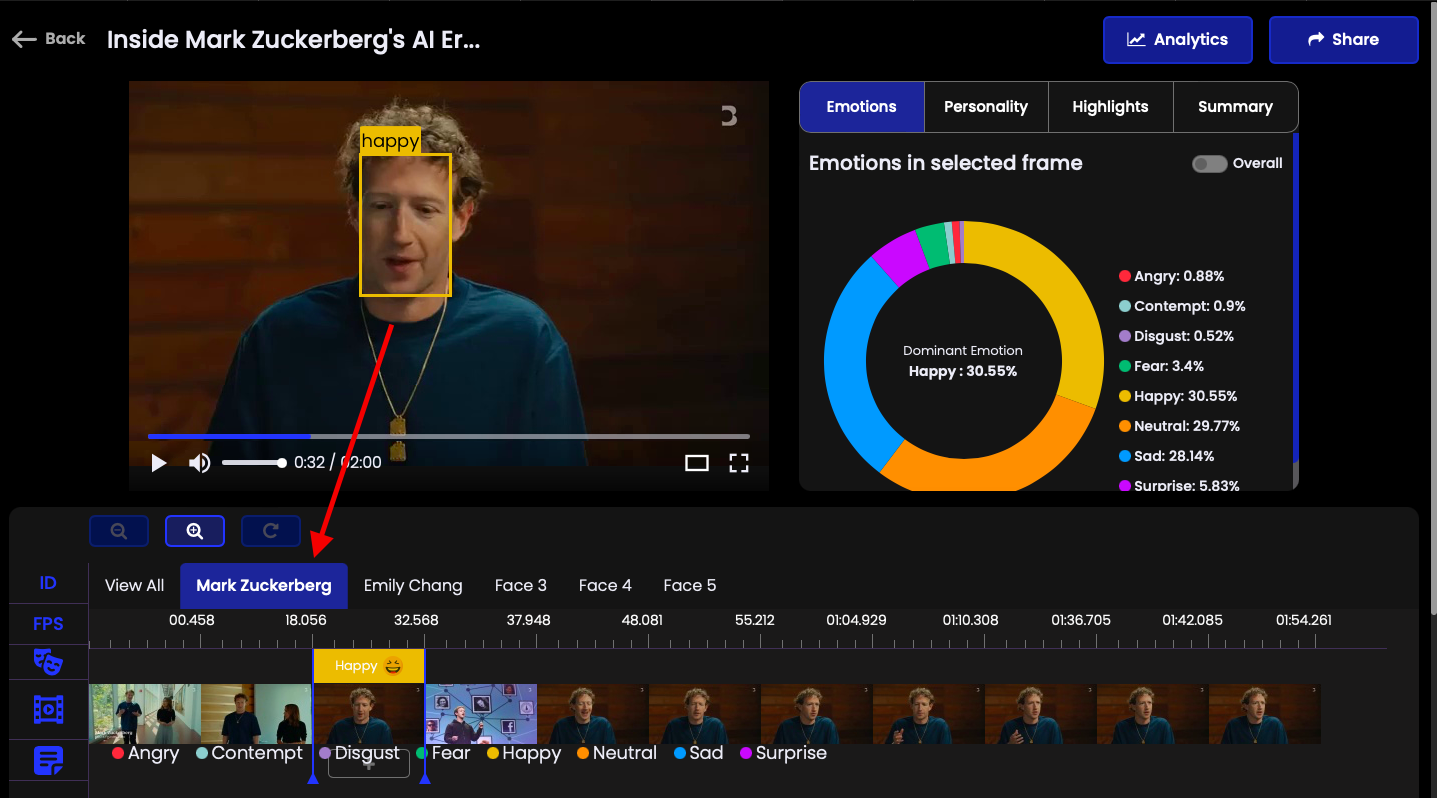
Neutral Expression:
- Significance: Typically signifies attentiveness, calmness, and a focus on the conversation.
- Implication: Zuckerberg’s neutral expression suggests he is deeply engaged in the discussion, reflecting a professional and thoughtful attitude.
Happy Expression:
- Significance: Moments of happiness imply comfort and satisfaction.
- Implication: When Zuckerberg displays happiness, it indicates he is at ease with sharing his ideas and is positive about the discussion. The transitions between neutral and happy expressions suggest a balance between serious contemplation and a more relaxed, approachable attitude.
Personality Traits Reflected
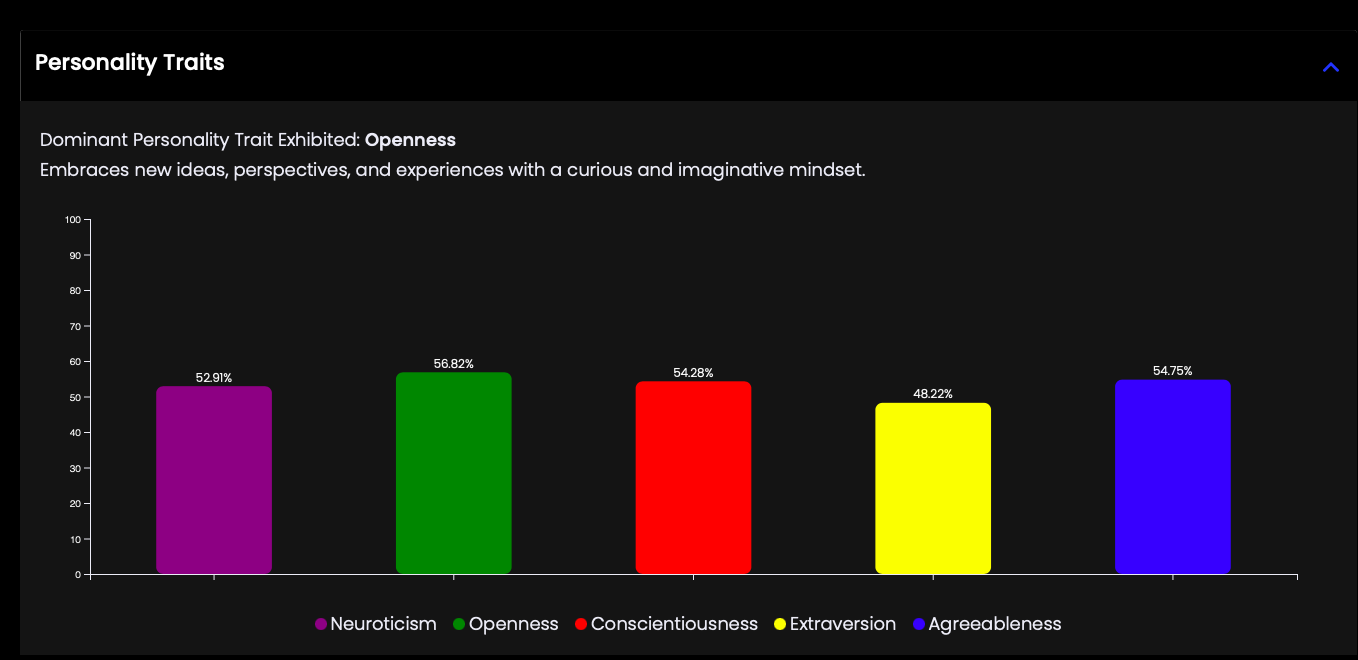
Agreeableness:
- Manifestation: Evident in Zuckerberg’s cooperative and respectful engagement with the interviewer.
- Alignment: His happy facial expressions align with a warm, friendly, and supportive nature.
Openness:
- Manifestation: Reflected in his readiness to discuss innovative ideas and new technologies.
- Alignment: His openness to new concepts contributes to the epistemic nature of the interview, highlighting a creative and forward-thinking mindset.
Conscientiousness:
- Manifestation: Shown through structured and organized responses, reflecting careful thought and responsibility.
- Alignment: This trait corresponds with the neutral expression, indicating a focused and deliberate approach to the conversation.
In this video interview (clip) analysis using facial emotion recognition software, the combination of these emotions and personality traits presents Zuckerberg as a knowledgeable and thoughtful leader. He balances intellectual engagement with a friendly, approachable nature, demonstrating both professionalism and an inviting attitude.
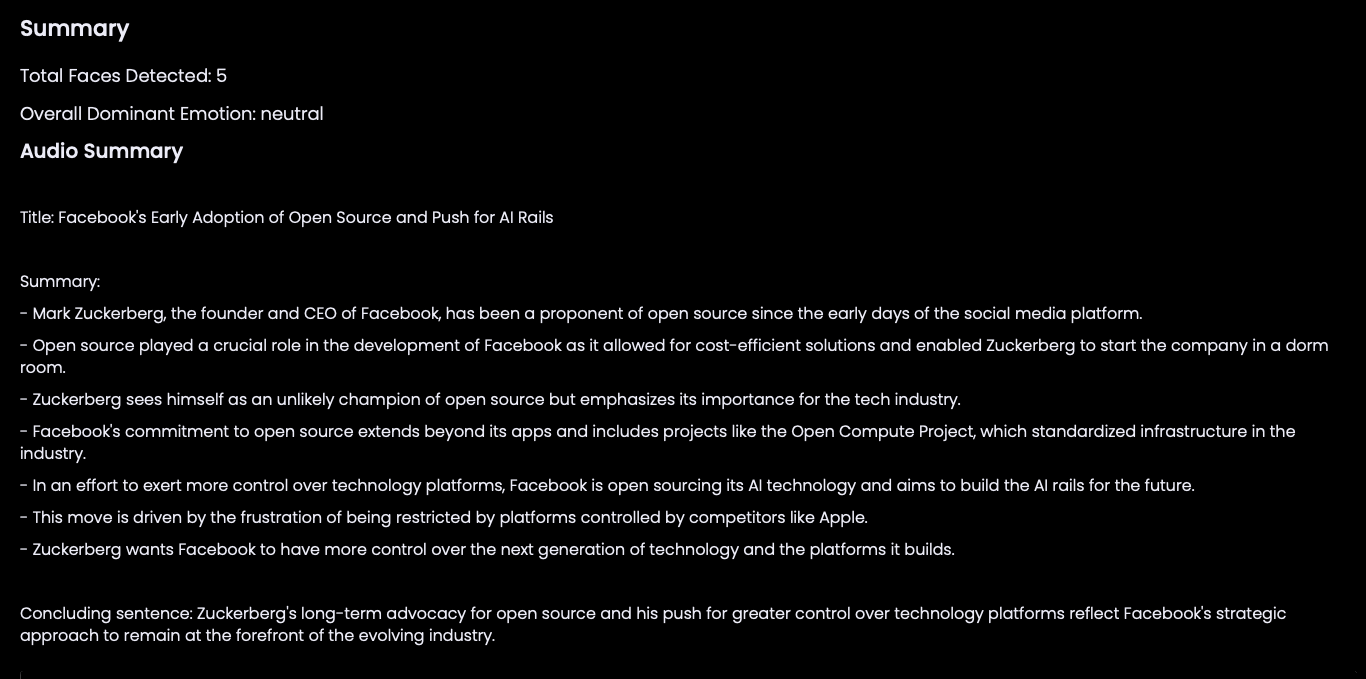
Our tool also provides a comprehensive video summary, breaking down the number of faces, overall emotional tone, and a summary of the key points of spoken content from the interview.
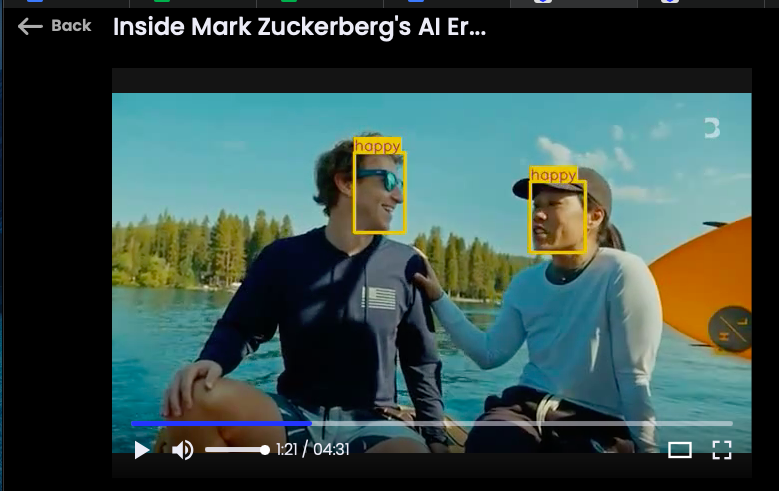
In the second setting at Lake Tahoe, the tranquil blue waters provide a soothing and natural backdrop for the conversation. This setting enhances the relaxed and intimate atmosphere, allowing for a more engaging and personal interaction between Mark Zuckerberg, his wife Priscilla Chan, and the interviewer, Emily Chang.
Overview of the interview clip
Casual and Enjoyable Interaction
The natural backdrop fosters a laid-back mood, encouraging open and friendly dialogue. Mark and Priscilla’s enthusiasm for surfing and their tips to Emily create a positive and supportive interaction.
Reflective Optimism
Mark’s discussion about AI showcases his optimism and belief in technology’s potential to enhance creativity. His thoughtful insights provide a hopeful perspective on future innovations.
Humorous Gesture
Mark’s light-hearted gift of sunscreen adds a touch of humor and reinforces the informal, approachable tone of the conversation.
Psychological Analysis
In analyzing the interview with Mark Zuckerberg, where the predominant facial emotion is happiness, and the overall emotional context is epistemic (focused on knowledge sharing), we look at how Facial Action Units (FAUs) and the Facial Action Coding System (FACS) help us understand these emotions.
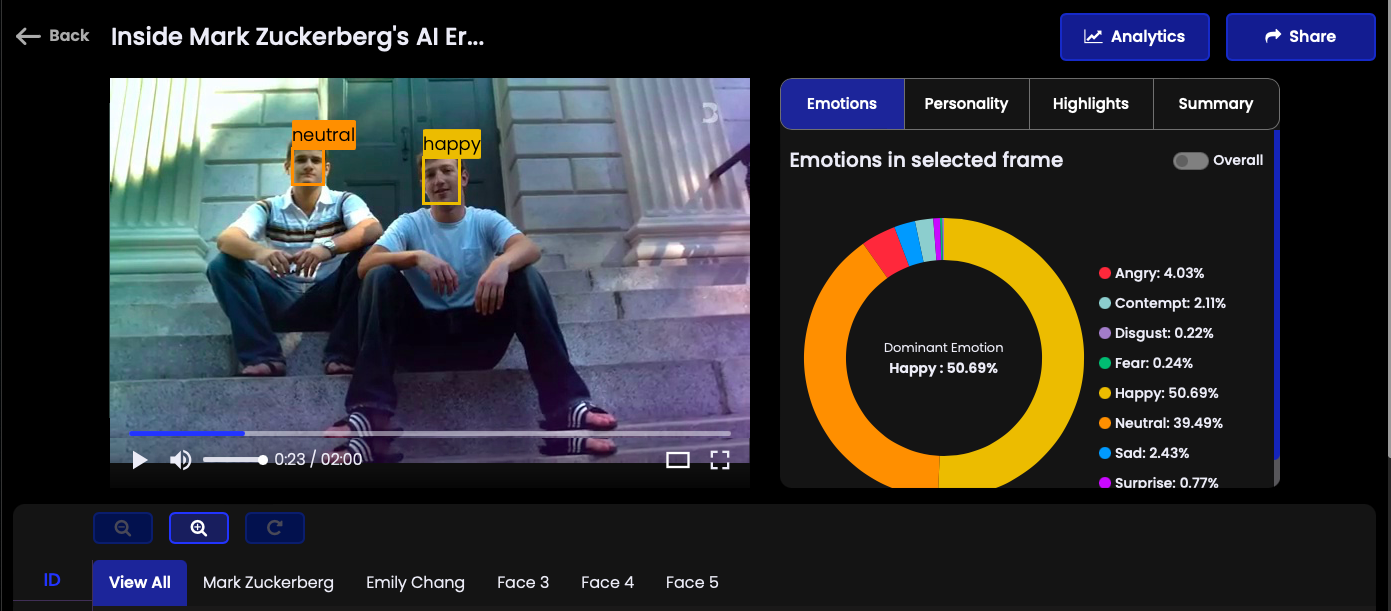
FACS (Facial Action Coding System)
The Facial Action Coding System (FACS) is a standardized system for classifying and analyzing human facial movements. It breaks down facial expressions into individual muscle movements (FAUs) that can be combined to represent thousands of different expressions. FACS is widely used in psychology, computer science, and other fields to study human emotions and behavior.
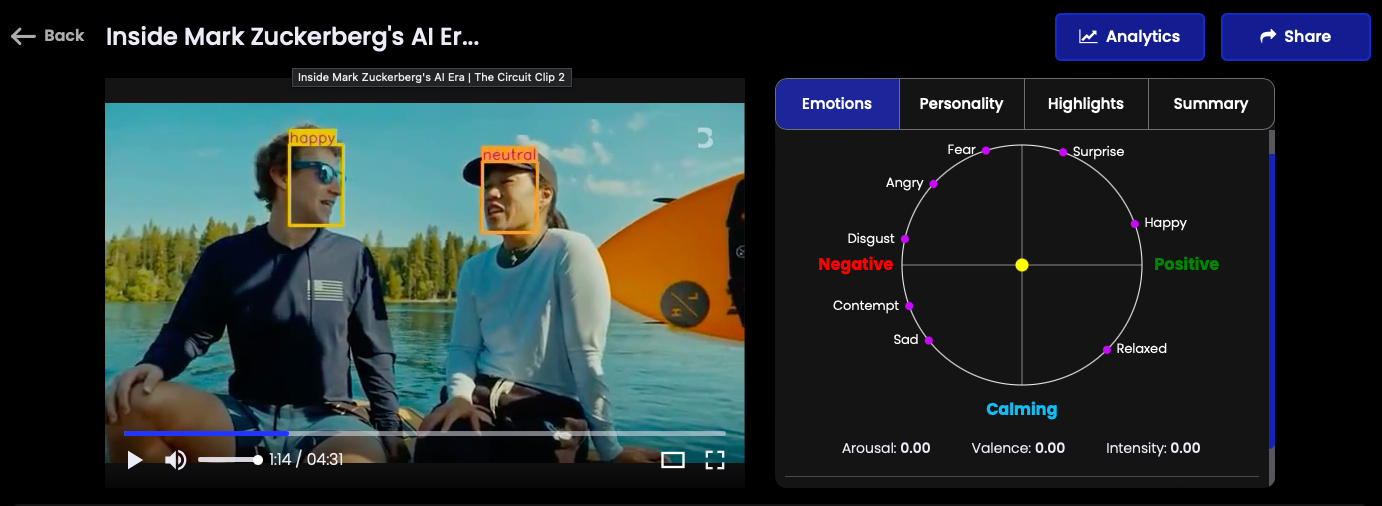
Key FAUs for Happiness:
- Action Unit 6 (AU 6) - Cheek Riser: This unit involves the raising of the cheeks, which creates crow’s feet or lines around the eyes. This action is a key indicator of a genuine smile, often referred to as a Duchenne smile. It signifies enjoyment and positive engagement.
- Action Unit 12 (AU 12) - Lip Corner Puller: This unit involves the upward movement of the corners of the lips, forming a smile. It is another crucial indicator of happiness and positive emotional expression.
In the Context of this Video Interview
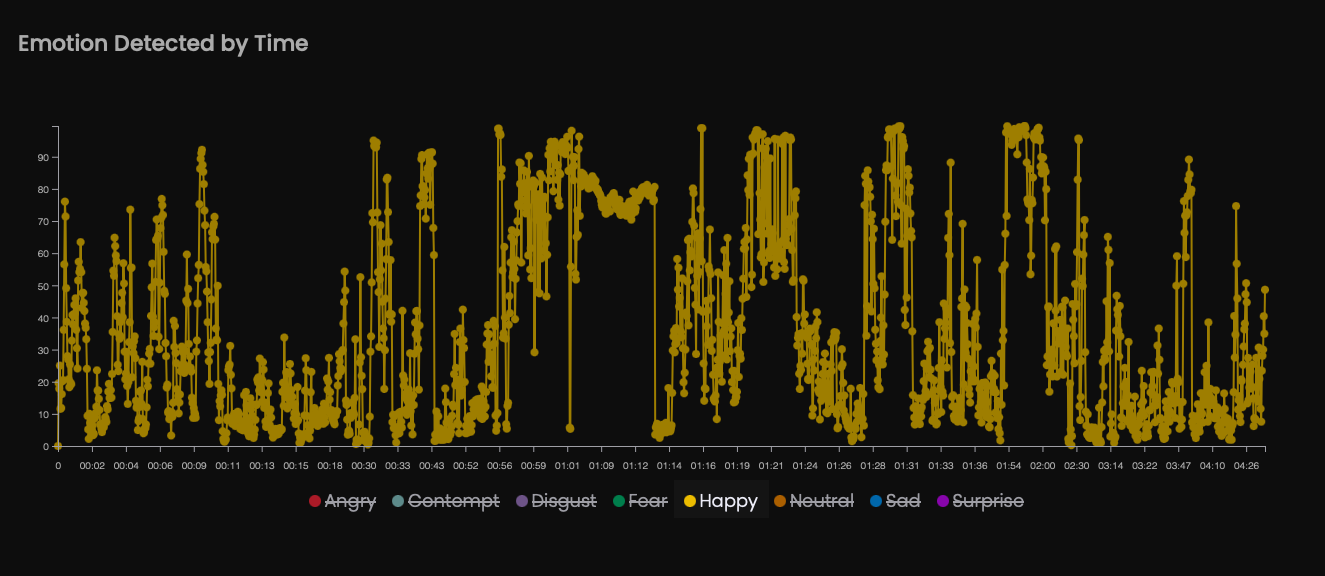
- AU 6: Observing AU 6 in Zuckerberg’s expressions suggests that his smiles are genuine, reflecting true enjoyment and positive engagement in the conversation.
- AU 12: Frequent occurrences of AU 12 reinforce the idea that Zuckerberg is experiencing consistent positive emotions, contributing to a happy and relaxed atmosphere throughout the interview.
Understanding Emotions from Facial Expressions
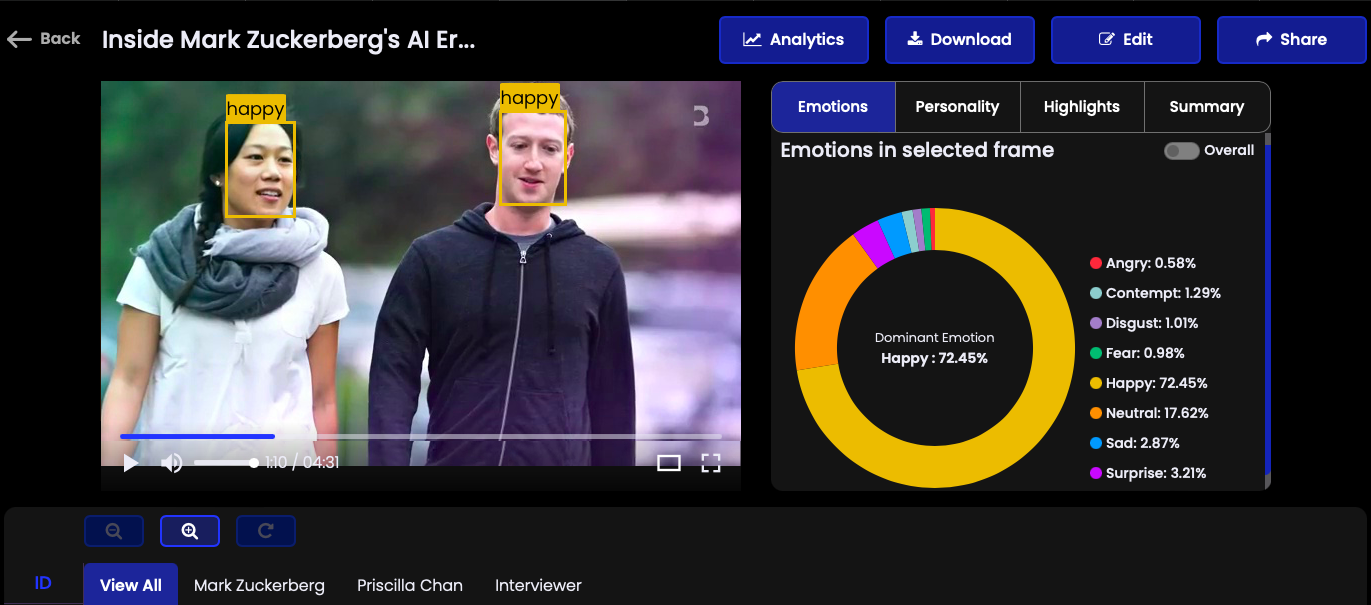
Facial expressions are essential for understanding a person's emotional state. By analyzing Zuckerberg's facial expressions, we can gain insights into his engagement and the epistemic nature of the interview.
- Genuine Smiles: The presence of AU 6 and AU 12 indicates that Zuckerberg is genuinely happy. This suggests that he is enjoying the conversation and is likely to be open and expressive about his thoughts and ideas.
- Eye Contact and Brow Movements: Maintaining eye contact and relaxed brow movements (minimal action in AU 1 - Inner Brow Raiser and AU 4 - Brow Lowerer) suggest attentiveness and a friendly nature. This reinforces Zuckerberg's agreeable personality trait.
Facial Expression and Personality Traits
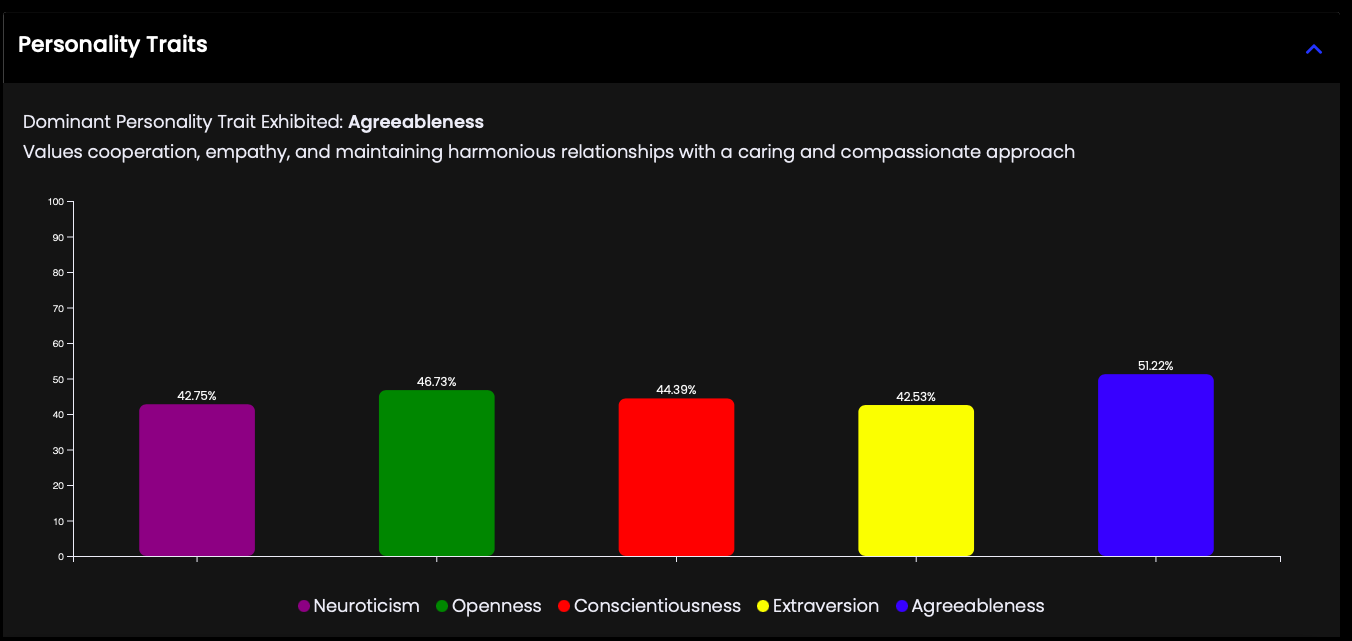
- Agreeableness: Zuckerberg’s agreeable nature is evident from his frequent genuine smiles (AU 6, AU 12) and positive eye contact. These facial expressions demonstrate that he is cooperative, friendly, and empathetic during the interview.
- Openness: Openness is inferred from expressive and animated facial movements. This includes raising eyebrows (AU 1) when discussing new or intriguing ideas, and having an overall relaxed and open facial demeanor, indicating curiosity and a willingness to share insights.
By examining Facial Action Units (AU 6 and AU 12), we can identify patterns in Mark Zuckerberg's facial expressions during the interview. The frequent occurrence of these units, associated with happiness, suggests a predominantly positive emotional state. This emotional tone, combined with overall positive facial cues, contributes to a perception of openness and approachability. Such an atmosphere can facilitate effective communication and information sharing.
We have demonstrated the potential to gain deeper insights into leadership styles and public persona by applying emotion recognition technology to analyze Mark Zuckerberg's public image. By decoding emotional cues,we can potentially identify qualities such as trustworthiness, empathy, charisma, and authenticity.
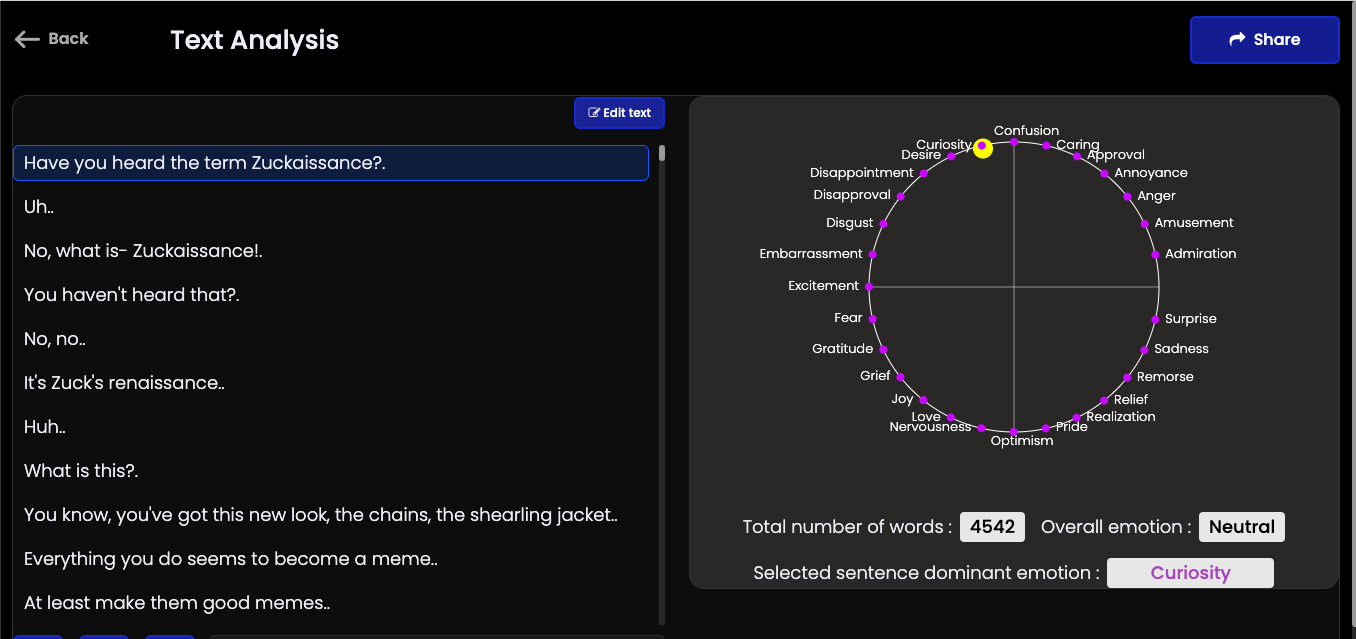
Here is the transcript analysis of the full interview using text emotion recognition. Out of 4,542 words, the overall dominant emotion is neutral. However, the analysis also uncovered a range of other emotions, including curiosity, realization, approval, and admiration, providing a deeper understanding of the emotional nuances throughout the conversation.For a detailed look at the analysis results, you can check it out here.
Click here to explore our text emotion analysis
This in-depth look at Mark Zuckerberg’s emotional and psychological profile offers a unique understanding of the traits that influence his leadership and decision making, providing valuable insights into the mind behind one of the world’s most influential tech giants.
As technology continues to advance, the ability to analyze emotions through video will become increasingly essential in understanding human behavior and interactions.
However, it's important to recognize that video analysis alone may not always capture the full context of a situation. Our emotion recognition tool offers multimodal analysis, integrating emotion detection through image, video, audio, and text.
This approach is crucial because it allows us to capture a wider range of emotional and contextual cues that might be missed when relying on a single modality. As a result, this multimodal approach will become increasingly essential in providing a deeper and more accurate understanding of human behavior and interaction.
Discover how understanding the emotional landscape of leaders can transform your perspective.